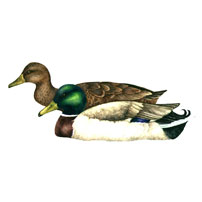The mallard was once called “the wild duck”, the term “mallard” being reserved for the drake.
It’s excellent on the table and all domestic ducks, excepting muscovies, are descended from the mallard. When plucking it, keep the feathers surrounding its preening gland. They are naturally oily and trap air, allowing fly-tiers to build a variety of deadly fishing flies such as the Cul de Canard Emerger.
Although tame on village ponds, the mallard is renowned for its wariness in the wild. To overcome this, wildfowlers use decoys and duck-calls. Calling duck has been developed into a minor art form in the USA, and the best compete at the annual World’s Championship Duck Calling Contest in Stuttgart, Arkansas.
In Britain, once every century, All Souls College, Oxford, holds a feast commemorating the giant mallard that flew out of the foundations of the college when it was being built in 1437. Its Fellows parade around the College singing the Mallard Song and led by a “Lord Mallard” who is carried in a chair, in search of the legendary fowl. The next Mallard ceremony will be in 2101.
In England and Wales all duck species must be shot with non-lead shot. The latter must also be used when shooting over wetlands in Scotland and Northern Ireland. Before using non-lead cartridges, it is essential to establish that the gun is suitable for such shot.
